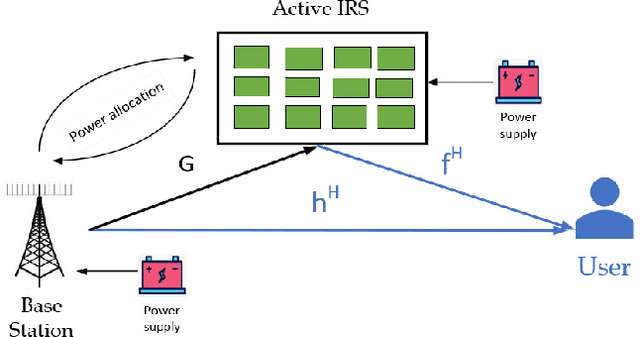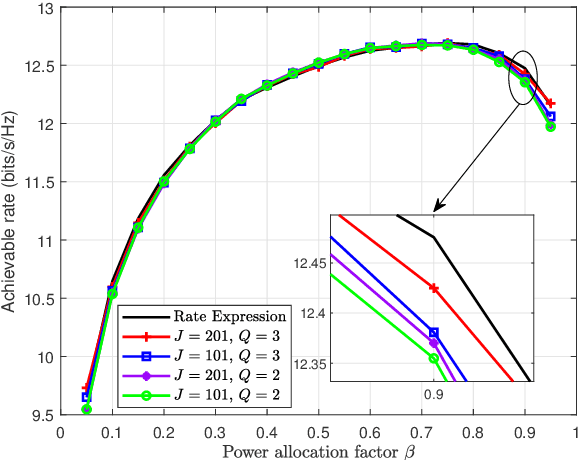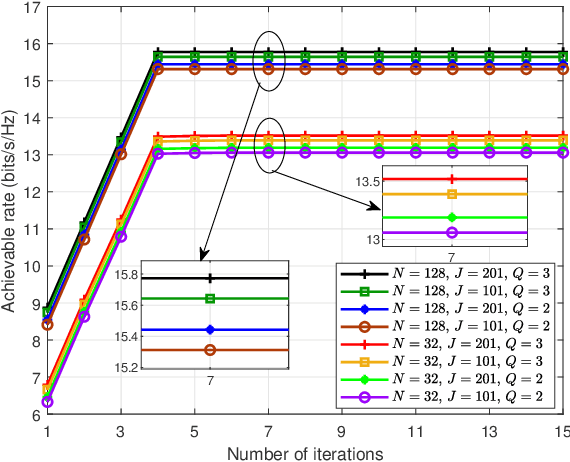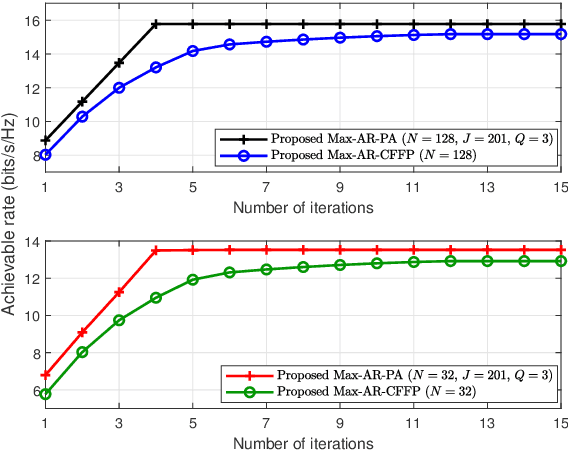Qiankun Cheng
Two Power Allocation and Beamforming Strategies for Active IRS-aided Wireless Network via Machine Learning
Jun 09, 2024



Abstract:This paper models an active intelligent reflecting surface (IRS) -assisted wireless communication network, which has the ability to adjust power between BS and IRS. We aim to maximize the signal-to-noise ratio of user by jointly designing power allocation (PA) factor, active IRS phase shift matrix, and beamforming vector of BS, subject to a total power constraint. To tackle this non-convex problem, we solve this problem by alternately optimizing these variables. Firstly, the PA factor is designed via polynomial regression method. Next, BS beamforming vector and IRS phase shift matrix are obtained by Dinkelbach's transform and successive convex approximation methods. To reduce the high computational complexity of the above proposed algorithm, we maximize achievable rate (AR) and use closed-form fractional programming method to transform the original problem into an equivalent form. Then, we address this problem by iteratively optimizing auxiliary variables, BS and IRS beamformings. Simulation results show that the proposed algorithms can effectively improve the AR performance compared to fixed PA strategies, aided by passive IRS, and without IRS.
Two Enhanced-rate Power Allocation Strategies for Active IRS-assisted Wireless Network
Oct 18, 2023Abstract:Due to its ability of overcoming the impact of double-fading effect, active intelligent reflecting surface (IRS) has attracted a lot of attention. Unlike passive IRS, active IRS should be supplied by power, thus adjusting power between base station (BS) and IRS having a direct impact on the system rate performance. In this paper, the active IRS-aided network under a total power constraint is modeled with an ability of adjusting power between BS and IRS. Given the transmit beamforming at BS and reflecting beamforming at IRS, the SNR expression is derived to be a function of power allocation (PA) factor, and the optimization of maximizing the SNR is given. Subsequently, two high-performance PA strategies, enhanced multiple random initialization Newton's (EMRIN) and Taylor polynomial approximation (TPA), are proposed. The former is to improve the rate performance of classic Netwon's method to avoid involving a local optimal point by using multiple random initializations. To reduce its high computational complexity, the latter provides a closed-form solution by making use of the first-order Taylor polynomial approximation to the original SNR function. Actually, using TPA, the original optimization problem is transformed into a problem of finding a root for a third-order polynomial.Simulation results are as follows: the first-order TPA of SNR fit its exact expression well, the proposed two PA methods performs much better than fixed PA in accordance with rate, and appoaches exhaustive search as the number of IRS reflecting elements goes to large-scale.
Beamforming Design for IRS-and-UAV-aided Two-way Amplify-and-Forward Relay Networks
Jun 01, 2023Abstract:As a promising solution to improve communication quality, unmanned aerial vehicle (UAV) has been widely integrated into wireless networks. In this paper, for the sake of enhancing the message exchange rate between User1 (U1) and User2 (U2), an intelligent reflective surface (IRS)-and-UAV- assisted two-way amplify-and-forward (AF) relay wireless system is proposed, where U1 and U2 can communicate each other via a UAV-mounted IRS and an AF relay. Besides, an optimization problem of maximizing minimum rate is casted, where the variables, namely AF relay beamforming matrix and IRS phase shifts of two time slots, need to be optimized. To achieve a maximum rate, a low-complexity alternately iterative (AI) scheme based on zero forcing and successive convex approximation (LC-ZF-SCA) algorithm is put forward, where the expression of AF relay beamforming matrix can be derived in semi-closed form by ZF method, and IRS phase shift vectors of two time slots can be respectively optimized by utilizing SCA algorithm. To obtain a significant rate enhancement, a high-performance AI method based on one step, semidefinite programming and penalty SCA (ONS-SDP-PSCA) is proposed, where the beamforming matrix at AF relay can be firstly solved by singular value decomposition and ONS method, IRS phase shift matrices of two time slots are optimized by SDP and PSCA algorithms. Simulation results present that the rate performance of the proposed LC-ZF-SCA and ONS-SDP-PSCA methods surpass those of random phase and only AF relay. In particular, when total transmit power is equal to 30dBm, the proposed two methods can harvest more than 68.5% rate gain compared to random phase and only AF relay. Meanwhile, the rate performance of ONS-SDP-PSCA method at cost of extremely high complexity is superior to that of LC-ZF-SCA method.
Beamforming and Phase Shift Design for HR-IRS-aided Directional Modulation Network with a Malicious Attacker
Feb 18, 2023Abstract:In this paper, we propose to use hybrid relay-intelligent reflecting surface (HR-IRS) to improve the security performance of directional modulation (DM) system. In particular, the eavesdropper in this system works in full-duplex (FD) mode and he will eavesdrop on the confidential message (CM) as well as send malicious jamming. We aim to maximize the secrecy rate (SR) by jointly optimizing the receive beamforming, transmit beamforming and phase shift matrix (PSM) of HR-IRS. Since the optimization problem is un-convex and the variables are coupled to each other, we solve this problem by iteratively optimizing these variables. The receive beamforming and transmit beamforming are obtained based on generalized Rayleigh-Ritz theorem and Dinkelbach's Transform respectively. And for PSM, two methods, called separate optimization of PSM (SO-PSM) and joint optimization of PSM (JO-PSM) are proposed. Thus, two iterative algorithms are proposed accordingly, namely maximizing SR based on SO-PSM (Max-SR-SOP) and maximizing SR based on JO-PSM (Max-SR-JOP). The former has better performance and the latter has lower complexity. The simulation results show that when HR-IRS has sufficient power budget, the proposed Max-SR-SOP and Max-SR-JOP can enable HR-IRS-aided DM network to obtain higher SR than passive IRS-aided DM network.
 Add to Chrome
Add to Chrome Add to Firefox
Add to Firefox Add to Edge
Add to Edge